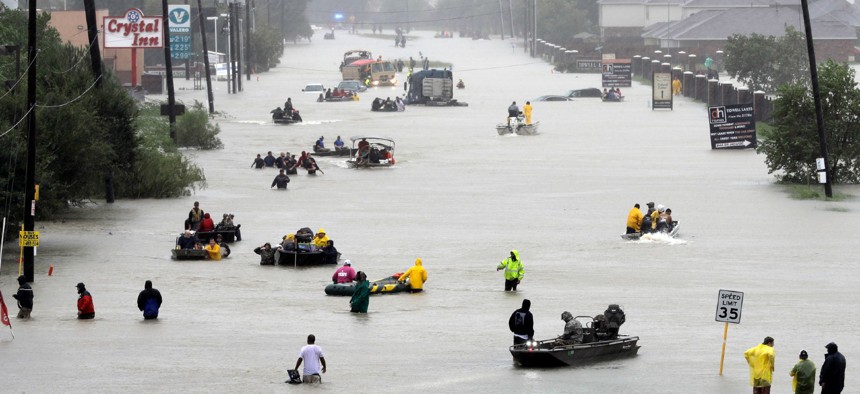
Rescue boats float on a flooded street as people are evacuated from rising floodwaters brought on by Tropical Storm Harvey in Houston in August 2017. David J. Phillip / AP file photo
Watchdog Finds ‘Minimal Oversight’ of Program to Help Workers Who Lose Their Jobs Following Disasters
IG proposes improvements based on a Labor Department agency’s response to 2017 hurricanes and wildfires.
A watchdog reported on Tuesday the Labor Department needs to improve its oversight of a program to help workers who lose their jobs as a result of disasters, to facilitate more efficient relief.
The Labor Department inspector general issued a report on how the Employment and Training Administration managed its funds from the 2018 Bipartisan Budget Act––following hurricanes Harvey, Irma and Maria and the wildfires in California in 2017––for its National Dislocated Worker Grants program. Under the program, the Employment and Training Administration gives out funds to states to reemploy those who have been laid off following disasters in temporary cleanup and recovery jobs and to make it easier for them to eventually find permanent work.
“We found that ETA provided minimal oversight of its state grantees and needs to improve the administration of the [Dislocated Worker Grant] program to ensure grantees help local areas restore communities in a timely manner, out-of-work participants receive expeditious disaster relief assistance, a greater number of participants obtain employment as intended by the grants and disaster relief funds are maximized and properly used,” said the report.
The IG reviewed the award process for all eight of the grantees (California, Florida, Georgia, Massachusetts, New York, Puerto Rico, Texas and the U.S. Virgin Islands); funds claimed from October 1, 2017, to May 25, 2019; and performance data as of December 31, 2019. Auditors also visited California, Florida and Puerto Rico. Out of the $135.6 million total approved in grant funds, $78.1 million was obligated.
The IG found it took between 25 days and almost six months for cleanup-related grants and about three to 13 months for evacuee grants to be issued because the Employment and Training Administration didn’t give criteria or guidance on what services should begin after there is a disaster declaration. This hindered grantees’ ability to restore their areas and provide disaster relief employment, the IG said.
Grantees also did not meet their performance goals, which the IG attributed to the Employment and Training Administration’s limited oversight as well as the states’ limited supervision of their sub-recipients. “Grantees only provided training services to about one-third of participants and only returned 39% of unemployed participants back to full-time employment. That percentage was below what was intended by the grants,” said the report. “Other performance outcomes were better but still didn’t reach the goal, including 85% of participants that were employed in temporary disaster relief assistance.”
Among the other challenges, approximately $4.5 million of grantee obligations and costs were either not needed for disaster relief or didn’t have sufficient documentation. “The majority of that resulted from $2.5 million that Puerto Rico had obligated for mobile units to help with disaster outreach, but had not spent as of two years after the hurricanes,” the report stated. “We also identified $1,988,627 in questioned costs, consisting of $1,556,584 for costs that were not supported by adequate documentation and $432,043 that were not necessary for the wildfire and hurricane grants.”
The IG made six recommendations to help the Employment and Training Administration prepare for future grant awards, which included establishing timelines for when disaster relief should be provided to those impacted; developing a strategy to work with state grantees to make sure that local areas are maximizing the use of their funds; evaluating how the agency monitors grantees, so they can better achieve performance goals; ensuring there is eligibility verification for grantees that have self-certification processes; and recovering the “questioned costs.”
Employment and Training Administration officials said they mostly agreed with recommendations and are taking corrective action on them, but took issue with a few aspects of the report, such as the IG’s “characterization that minimal oversight of the states was provided.” The IG said that nothing in the agency’s response changed its report, however.
While issued during the Biden administration, the report covered actions taken only during the Trump administration.
President Trump tapped John Pallasch to lead the Employment and Training Administration in April 2018, but he wasn’t confirmed until July 2019, so there was a series of interim directors. For the first two years of the Trump administration, “staffers across the [agency were] getting moved around causing at the very least confusion on who is in charge of what, and at the most a loss of experienced staff,” Bloomberg News reported in February 2019. “It [was] not just Pallasch’s vacancy that [was] causing concern.”
Susan LeVine, former Washington state Employment Security Department commissioner and ambassador to Switzerland under President Obama, was appointed to be principal duty assistant secretary of Labor for employment and training on Monday, a Labor Department spokesperson told Government Executive, which means she is the de-facto head of the Employment and Training Administration. Nancy Rooney is still the career deputy assistant secretary.







